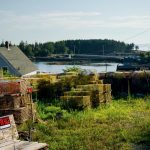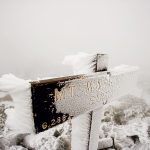Born to be a Tugboat Captain | Traditionalists
Doug Fournier describes his job, Tugboat Captain, as “hours of boredom with moments of sheer terror.”
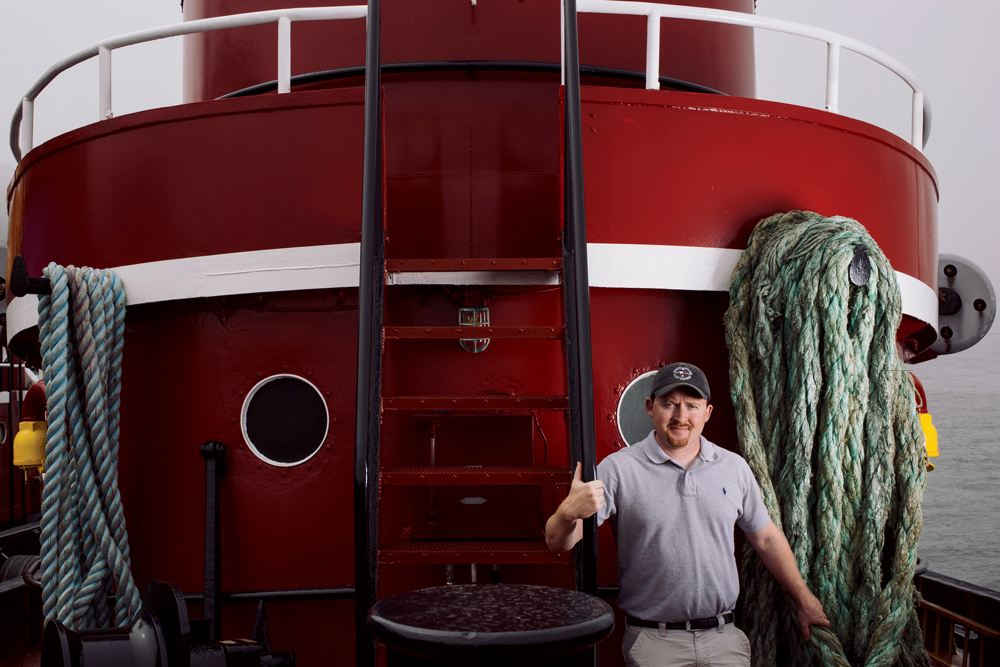
Coffee By Design | Portland, Maine
Photo Credit : Katherine KeenanDoug Fournier knows that he’ll be noticed only if something goes wrong. Which is why he describes his job, Tugboat Captain, as “hours of boredom with moments of sheer terror.”
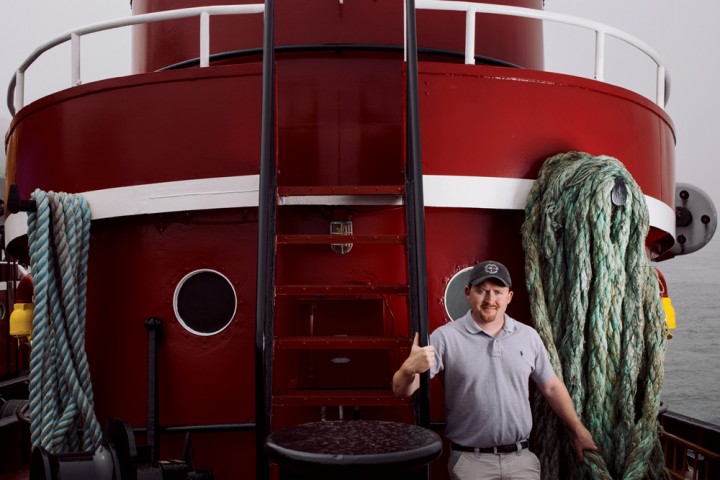
Photo Credit : Tristan Spinski
Every day thousands of merchant vessels and perhaps several hundred mammoth cruise ships ply the oceans, each one needing eventually to come to port. These are the ships we pay attention to, some so large they block the horizon, a wall of steel rocking on the waves. All but unnoticed are the tugboats, seemingly a child’s vision of a boat—but inside those tugboats, steering the steel walls into the safety of the harbor, are the captains.
These men and women aren’t simply glorified tow-truck drivers. No: It could be argued, in fact, that they may just be the most talented and vital captains working the sea. Yet they’re all but invisible unless something goes terribly wrong: A grounded barge or, worse, a massive oil spill thrusts a tugman’s life into the unwelcome spotlight. As these captains like to say, any day they can avoid the front pages or stay off CNN is a good one.
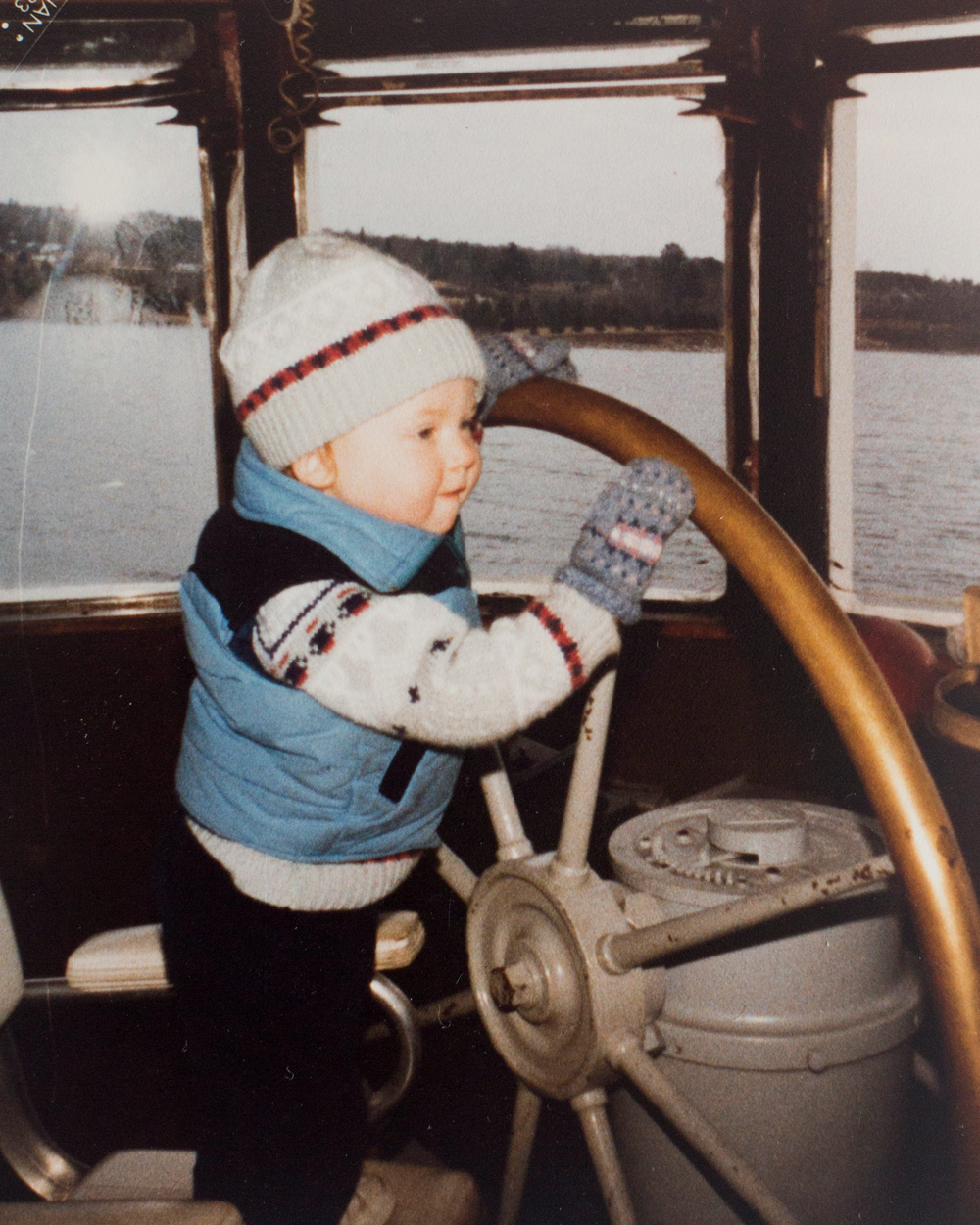
Photo Credit : Courtesy of Doug Fournier
Few know this world as intimately as Doug Fournier, a second-generation tug captain who runs the family business in Belfast, Maine. As they frequently do, his days start early. This one in late August is no exception. It’s 4:30 a.m. and the Sprague shipping terminal in Searsport, Maine, is quietly churning with life: a working scene bathed in yellow sodium light that’s never at rest. Smoke billows from several large, round container buildings filled with liquid asphalt, while nearby a load of recently shipped road salt waits to be hauled away. It’s the same down at the water, where a barge of windmill turbines will soon be emptied. Across the dock, a team of deckhands scurry around two red tugs, the Tractor and the Fort Point.
Through the inky-black morning Doug Fournier rolls his truck up to the security checkpoint, punctuated by a pair of rolling chain-link fences. He parks and enters a small building, where a guard with heavy eyes sits behind a desk.
“What are you takin’ up?” he asks as Fournier fills out the sign-in sheet.
“The Maersk Katalin,” he answers. “Bringing her into Bucksport to offload heating oil before she heads back home to St. John [New Brunswick].” He pauses. “That’s the plan, anyway. I just don’t know what the fog is going to be like today. It was a little soupy coming through downtown Searsport.”
The guard shrugs. “I don’t think it’s going to be that bad,” he says. “The moon was out just a couple of hours ago.”
Fournier raps his fingers on the sign-in sheet. “We’ll see what we have to deal with shortly,” he says.
Soon, Fournier is on the other side of the security fence, where he parks his truck and steps outside to slip on a life jacket. He’s 34, with closely cropped reddish-brown hair and a round face whose youthful appearance is slightly offset by a neatly trimmed goatee. He gives a slight upward tug on his pants belt, then makes his way to the boats. Upon approaching the Fort Point, he looks down at the deck and then back up with a slight smile. “Hope you don’t mind ladders,” he says.
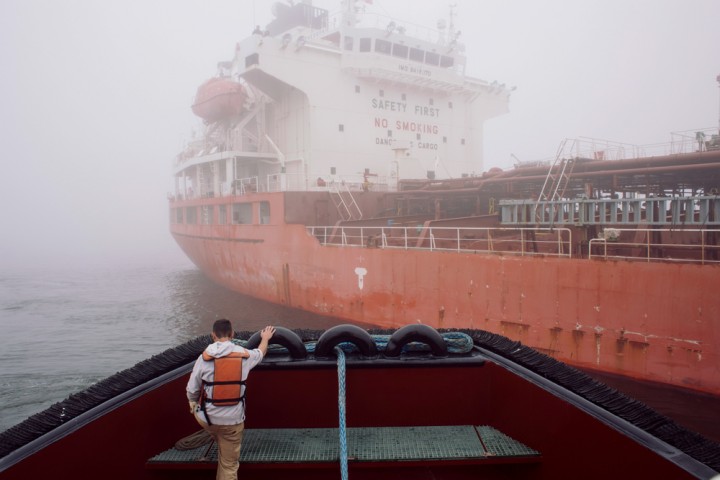
Photo Credit : Tristan Spinski
Dressed in brown khakis and a black-collared short-sleeve shirt, Fournier bounds easily onto the boat, walks briskly across the deck, and then steps onto the Tractor, an 85-foot tug whose 3,000-horsepower engine is easing into a steady rumble. He climbs the steps to the wheelhouse and then takes his seat in the captain’s chair. In the distance, the steady orange lights of the Maersk Katalin, a barge about the size of two football fields with a carrying capacity of 10 million gallons of oil, dot the blackness.
The inside of the wheelhouse is a comfortable place of big windows and wood-paneled walls. The décor is functional. Three CB radios swing from the ceiling, while a trio of monitors hang at eye level. Near the steering controls sit a beefy pair of black binoculars and a thick red-covered logbook. As the morning deepens, the Tractor is untethered and Fournier begins his commute. The Fort Point follows behind. The calm harbor is an easy pathway, still and peaceful. Lobster buoys gently ride the calm water, and as the sky lightens, the contours of the surrounding landscape—Sears Island, Cape Rosier, the north tip of Islesboro—come into view.
Fournier’s feel for these waters and for his boat stems from experience and genetics. From the time he could just about walk, his father, Arthur Fournier, a longtime tug captain, had him inside a wheelhouse. Before he was old enough to shave, Fournier ran tugs with his dad in Portland Harbor; at 19, an age when new recruits are just getting their first taste of the Maine Maritime Academy, he already had his captain’s license. By his mid-twenties he was running the family business in Belfast. Today, Fournier owns and operates Penobscot Bay Tractor Tug Company with his younger brother, Patrick. From a first-floor office overlooking Belfast Harbor, they schedule some 300 jobs a year, many of them handled by the Fourniers themselves.
At slow speeds and in shallow waters, the freighters that bring our fossil fuels and big machinery into port are at the mercy of winds and currents. Tugs stabilize and direct them into harbors. It’s a slow, meticulous dance of pushing and pulling, one that sometimes must contend with turbulent weather, with little room for error. It’s why tug captains are considered some of the finest practitioners of their craft. In New York, Boston, and Portland harbors, Fournier’s father prided himself on guiding wide ships under bridges where there was just a few feet to spare between the pilings.
There are no serious obstacles on this day. But the fog persists. About an hour into the trip, Fournier’s phone rings. It’s the docking pilot, who, from his perch inside the big ship’s wheelhouse, directs the tanker and tug captains on how to navigate the harbor. “He’s calling my cell phone,” Fournier says, tightening his lips. “That’s never a good thing.”
The news is immediate: The fog is too thick upriver to continue. They’ll have to try again at the next tide, in late afternoon. “It’s the nature of the business,” Fournier says, wheeling his tug around to point it back to Searsport. “We’re working around the elements. That’s what controls what we do.”
—
Tugboats wield a power over the imagination like few other boats. Their bright colors, their stout design, their plodding pace—they’re working ships with a playful appeal. But the allure and uncertainty of what these vessels do also carry weight, says Ron Hawkins, a native Mainer and tug captain who left his family’s windjammer business some 30 years ago to work for Arthur Fournier. “There’s a romance to it that attracts a young guy,” says Hawkins, who learned the business under Arthur Fournier and now works for Doug. “There’s something about a 24-hour industry. You hear a train whistle in the middle of the night, or a tug whistle, and you wonder, What are they doing? Where are they going? It’s a mystery.”
There was never any question that Doug Fournier would seek out the mystery. His late father, Arthur, who made his life on the sea driving tugs, made sure of that. Arthur left school in Massachusetts after the seventh grade and by the age of 15 was a deckhand on a barge running up and down the East Coast, picking up coal, shoe leather, and fertilizer.
Before he was 20, Arthur had his own boat, the St. Theresa, a 45-foot wooden tug that he’d bought for a buck, salvaged from the bottom of the Charles River, and restored in the backyard of his family’s home. In a fit of frugality that would define his life, he powered it with an old motor from a wrecked Greyhound bus.
Over the next several decades, Arthur got to know every inlet, current, and waterway of the Northeast harbors. In the early years especially, he was a one-man operation, relishing going up against and securing jobs from bigger, more established competitors. In New York, he was known by other boatmen as “the captain with a dog for a deckhand” for frequently doing work that required two or three other men.
Standing just over five feet, favoring a wardrobe of black sneakers and grease-stained corduroys, Arthur could at times seem like a character from a Martin Scorsese film. “On a good day, every other word was a swear word,” a longtime captain once recalled, “but on a bad day, it was just a slobber of profanity.” In 1972, he was caught in a gunfight against three assailants at his office in Charlestown, Massachusetts. He took 12 bullets during the exchange, but not before unloading four shots into one of his attackers and successfully fending the group off.
By the mid-1980s, Arthur had moved north to Maine: first to Belfast, where he revamped an aging tug outfit he’d bought; then to Portland, where he upended the city’s tug business by driving out Moran Towing Company, which had held a virtual lock on harbor work in the city for nearly half a century. For four long years, Arthur picked away at his more-established competitors until finally Moran pulled its boats. “Don’t gloat,” a company executive told Arthur coldly.
Tug work defined everything about the elder Fournier. It made him wealthy, shaped his greatest successes, and framed his biggest tragedies. In 1985, his oldest son, Billy, died trying to save another man in an accident aboard a barge in Belfast, Maine. Not even the discovery of his cancer got him to slow down enough for treatment. Then, when his 82-year-old body was weakened he could push himself no longer, he had his bed positioned so that he could look out at the water from his South Portland home to see boats marching across the horizon.
But as Arthur Fournier put his work ahead of nearly everything else in his life, he also forged complicated relationships with those around him. He was a demanding boss with a quick temper, and he passed and pushed his passion for tugs onto his kids. His four sons all followed him into the business: Billy and Brian, from his first marriage; Doug and Patrick from his second. The father’s work framed his relationship with his boys. After dinner he’d pull out his copy of the American Bureau of Shipping and randomly open to different boat profiles. Doug and Patrick were expected to know a boat’s details: its size, the type of engine it used, where it was made. Family vacations were often spent in New York City to watch the tugs run the harbor. Later, father and sons finished their stay by visiting a salvage yard on Staten Island to climb around the old boats.
“He’d take us out of school if he needed us,” Doug remembers. “I’d get pulled out of class and think something tragic had happened, but no, he needed us to help him dock a ship.”
When he was 15, Doug Fournier was plying the calm Portland waters with his own tug, a 26-footer called the Pushy. It wasn’t just a hobby toy: It was a part of the Fournier fleet and used on jobs that Arthur’s bigger boats couldn’t handle. The most notable of those came in the summer of 1997, when a ship caught fire in Portland Harbor. Arthur’s larger tugs couldn’t reach her, so the call went out for the Pushy. Through the smoke and flames, Doug and Patrick moved the burning mess onto mud flats, where firefighters could reach her.
Five years later, Fournier was licensed to run his father’s entire fleet. “It was just expected that I would become a tug captain,” he says. “There wasn’t an option to do anything else. My dad would say, ‘You’re going to go to college and do what? Work at McDonald’s?’ That was his famous line. He’d tell us we could have everything we want if we just work. He was right.”
Today, the Fournier headquarters in Belfast serves as a sort of museum of the industry and the family business. A large photograph of a smiling Billy hangs just outside Doug’s office. On the other walls there are framed pictures of memorable jobs and past tugs, including some of Arthur’s earliest boats. One of the largest images is an aerial shot of the now-retired ocean liner Queen Elizabeth 2, when it was docked at Bar Harbor in the fall of 2007. Anchored next to it is the Tractor, which Fournier and his brother Patrick captained during the big ship’s stay. Along for the job was their father.
“It brings up a lot of nostalgia,” Fournier says of the image. “I remember seeing pictures of the QE2 in places all over the world, and before I was even old enough to be a deckhand, I’d ride out with my father and see it when it came to Maine. Later, when it came to Portland, I assisted my father with it. So when the chance came up in Bar Harbor, I couldn’t pass it up. That was one job I wasn’t going to miss.”
—
Hours later, the fog is long gone and an evening sun has poked through the clouds as Fournier pulls the Tractor in behind the Maersk Katalin. He’s been running with the tanker for a good 45 minutes, but now, near the Penobscot Bay Bridge, the captain gets in tight. The full girth of the steel ship is on full display, and Fournier’s 365-ton tug looks like a toy in comparison.
When Fournier is within just a few feet of his target, a deckhand throws the casting rope to the tanker; it will tie the Tractor’s beefy blue line to the larger ship. Up ahead, Four-nier’s other tug, the Fort Point, is tying on as well. Over the next three-quarters of a mile, tugs and ship run together.
Fournier works calmly. He’s a bridge between the scrappy, self-reliant business his father cut his teeth on and the modern, computer-driven industry of today. He still likes working on boat engines, and when he’s short on crew, he’ll take the reins of the deckhand work. But the boats themselves afford a level of technology his father never could have imagined when he started out in the business more than 60 years ago. Back then, Arthur Fournier navigated by magnetic compass and a paper chart. Today, the Tractor is outfitted with digital radar, GPS, and chart-navigation software offering near-perfect positional accuracy. An autopilot feature lets Fournier punch a route into a chart plotter, which with a push of a button allows the tug to steer itself to its destination. On his iPhone he can even track another vessel and call up necessary info about it, including its size, draft, speed, and position. “If we have a ship scheduled to dock in Searsport in the middle of the night, the first thing I do when I wake up is to check Marine Traffic to make sure the vessel is on schedule,” he explains. “It allows me to keep an eye on our fleet when my crew is out on a job and I’m in the office or out of town. I know where they are at all times.”
But unpredictability is still a part of the work: a sudden engine failure; a bout of weather; an emergency call. Just a week earlier, Fournier was called to tow in an 80-foot yacht whose motor had died just off Islesboro. The scheduling, too, can get complicated. This morning’s change means that he’ll be home at 9:00 tonight, then back on the job the next afternoon to bring in another shipment of oil. A few hours after that, he’ll tow the Maersk Katalin back out to sea. That lack of routine caters to Fournier; it means he’s never completely untethered from his work. He’s like his father in that way. He finds meaning in what he does. It’s who he is. It’s what he enjoys doing. It’s why he hasn’t burned out or taken a real vacation in the last 12 years. “I’d worry about the business too much if I was away,” he says. “Maybe I’ll ease back at some point, but I don’t know. My father never did. He could never let go. He worried about it. Three years before he died he could race up and down a ladder twice as fast as me. He had no intention of sitting in a rocking chair and fading away.”
As it nears 7:30, the sky above Bucksport has grown overcast again, and a mild fog has settled just above the tall pines along the water. Near the shore, a scattering of anchored pleasure boats ride along the gentle water. Up ahead lies the Maersk Katalin’s destination for the night: the dock at the recently closed paper mill, a darkened collection of big, boxy buildings and tall smokestacks.
![Doug (left) and Patrick Fournier with their late father, Arthur J. Fournier. “My father never [eased back],” Doug says today. “He could never let go … Three years before he died he could race up and down a ladder twice as fast as me.”](https://newengland.com/wp-content/uploads/2016/01/Family-Pic.jpg)
“He could never let go … Three years before he died he could race up and down a ladder twice as fast as me.”
Photo Credit : Courtesy of Doug Fournier
The ride since the bridge has required a series of small adjustments. Easing forward to run with the Maersk Katalin, then easing back to slow her down. It’s over the journey’s final 100 yards, however, that the work becomes the most detailed. Precise orders come over the radio from the pilot to push, pull, and hold as he works to position the big ship to slowly and easily slide up to the dock: “Tractor, down to a minimum; Tractor, stop and hold; Tractor, minimum back.” On it goes until the Maersk Katalin is in place and tied up.
“Kind of boring,” Fournier says. He smiles. “But the best kinds of joys are boring in this business. Hours of boredom with moments of sheer terror.” Fournier then hits the throttle and pushes his boat to the dock to be tied up for the night as well. A truck is parked nearby. It’s time go home so that he can catch some brief sleep and start the day all over again.





